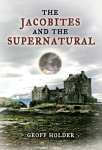
Publication Details
Amberley Publishing. ISBN 9781848685888
Publish date
Reviewed by Tom Ruffles
The prolific Geoff Holder, who has written widely on the paranormal, mostly in connection with Scotland, does something slightly different in his latest book by drawing together a range of supernatural lore relating to the ill-fated Jacobites. Taking this thematic approach allows him to create a useful gazetteer for those interested in the supernatural, Jacobite history, and the fractious relations which have often prevailed between England and Scotland.
The book is divided into several sections. The first is a succinct but clear exposition of the historical context – the political, religious, and social divisions which generated so much strife – including a useful timeline. This part provides a foundation to understand the people and beliefs involved in the somewhat complicated narrative of Jacobitism. The second looks at how the supernatural was viewed and interpreted in the late seventeenth and early eighteenth centuries. This covers such matters as omens, prodigies and prophecy, and how they played a role in propaganda and the shaping of events (often becoming self-fulfilling); how the monarch’s effectiveness at employing the King’s Touch, being God-given, came to be seen as a criterion for assessing legitimacy; second sight; witchcraft and magic; fairies; and of course ghosts.
These two sections form the framework for understanding the third, which is the location guide. This is divided into Scotland, England and Ireland, and Scotland and England are further sub-divided into regions for Scotland and counties for England. Naturally most pages are devoted to Scotland. Site entries follow a standard format: the date when it became significant, where it is, including a map reference and the postcode to assist GPS users, what there is to see today, visitor information, what happened there, and of course the weird stories, including Jacobite ghosts. As not every location associated with the Jacobites has such stories attached to it, this is not a complete guide that movement (though it does include all the major battles), only the stranger bits of it.
The volume concludes with a bibliography and an index which makes searching the book easy. The whole is liberally sprinkled with illustrations, many taken by the author, showing that he put his boots on to do his research rather than sitting at his desk with a pile of tourist brochures. As a package this scores well compared to many regional volumes which do not allow someone trying to use them as field guides to locate information easily. It is also worth stressing that although Holder’s background is in the paranormal, he is very good on the personalities, and describes battles very clearly.
Some of the stories will be familiar from other collections, but Holder has taken a novel approach in focusing on the life and times of the Jacobites, and produced an extremely worthwhile guide as a result. The text is well written, though the language is sometimes informal veering into slang. What he has achieved is to write a book that will appeal to fans of the paranormal as much as to those who enjoy visiting battlefields or historic houses, while injecting some serious history in a palatable form which manages to combine a quizzical eye for folly with compassion for the suffering such folly causes. Whatever one’s opinion of the folklore and strangeness he recounts, the general reader will close the book knowing a bit more about this tragic period than when he or she opened it.

